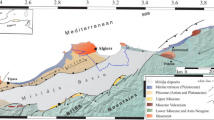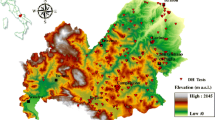Abstract
We develop seismic microzonation maps in Seoul employing a GIS-aided approach. We use extensive borehole database of Seoul, which include stratigraphical information and standard penetration test (SPT) results. Two outlier detection methods are used to remove unreliable data. VS profiles are developed empirically both from SPT blow counts where available and averaged values representative of geologic soil layers where only stratigraphical information are provided. The sites are classified using the Korean design system (KDS) and a revised site classification system of Aaqib et al. (Earthq Eng 26:8257–8279, 2022, DOI:10.1080/13632469.2021.1990164), (AEA22). It is revealed that the KDS system, which uses the bedrock depth and average VS of soil, is not effective in categorizing the sites, resulting in significant overlapping of site parameters for different classes. The site period dependent AEA22 system better captures the surface geologic variations in Seoul, producing cleaner yet more representative classification map. We further develop the surface spectral acceleration maps of Seoul subjected to a 2400-year return period earthquake. The seismic amplifications are calculated using three procedures, which are (1) simulation-based site amplification model of Aaqib et al. (Earthq Spec 37:1900–1930, 2021, DOI:10.1177/8755293020981984) developed for shallow bedrock sites of Korea, (2) KDS and (3) AEA22 amplification factors. The site amplification model is considered as the reference method. The KDS system produces unrealistic predictions, underestimating the short period accelerations while overestimating the mid-to-long period responses. The AEA22 system produces an enhanced predictions of the surface accelerations compared with the KDS system. We propose to utilize the site amplification model or the AEA22 system for estimation of the seismic hazard in Seoul.























Similar content being viewed by others
References
Aaqib M, Park D, Adeel MB, Hashash YMA, Ilhan O (2021) Simulation-based site amplification model for shallow bedrock sites in Korea. Earthq Spec 37:1900–1930. https://doi.org/10.1177/8755293020981984
Aaqib M, Park D, Lee YG, Pervaiz U (2022) Development of site classification system and seismic site coefficients for Korea. J Earthq Eng 26:8257–8279. https://doi.org/10.1080/13632469.2021.1990164
Anthymidis M, Theodoulidis N, Savvaidis A, Papazachos C (2012) Constraining site response and shallow geophysical structure by ambient noise measurements and 1D numerical simulations: the case of Grevena town (N. Greece). Bull Earthq Eng 10:1685–1716. https://doi.org/10.1007/s10518-012-9378-3
Ashayeri I, Memari MA, Haghshenas E (2021) Seismic microzonation of Sarpol-e-zahab after Mw 7.3 2017 Iran earthquake: 1D-equivalent linear approach. Bull Earthq Eng 19:605–622. https://doi.org/10.1007/s10518-020-00999-6
Baturay MB, Stewart JP (2003) Uncertainty and bias in ground-motion estimates from ground response analyses. Bull Seismol Soc Am 93:2025–2042. https://doi.org/10.1785/0120020216
Borruso G (2005) Network density estimation: analysis of point patterns over a network. In: Gervasi O, Gavrilova ML, Kumar V, Laganà A, Lee HP, Mun Y, Taniar D, Tan CJK (eds) Computational Science and Its Applications–ICCSA 2005, Berlin, Heidelberg, 2005. Springer Berlin Heidelberg, Berlin, pp 126–132
Brandenberg SJ, Bellana N, Shantz T (2010) Shear wave velocity as function of standard penetration test resistance and vertical effective stress at California bridge sites. Soil Dyn Earthq Eng 30:1026–1035. https://doi.org/10.1016/j.soildyn.2010.04.014
Cetin K, Zarzour M, Çakır E, Tuna S, Altun S (2023) 2-D and 3-D basin site effects in Izmir-Bayrakli during the October 30, 2020 Mw7.0 Samos earthquake. Bull Earthq Eng 21:1–24. https://doi.org/10.1007/s10518-023-01738-3
Codermatz R, Nicolich R, Slejko D (2003) Seismic risk assessments and GIS technology: applications to infrastructures in the Friuli-Venezia Giulia region (NE Italy). Earthq Eng Struct Dyn 32:1677–1690. https://doi.org/10.1002/eqe.294
Dikmen Ü (2009) Statistical correlations of shear wave velocity and penetration resistance for soils. J Geophys Eng 6:61–72. https://doi.org/10.1088/1742-2132/6/1/007
Dung NT, Chung SG, Kim SR, Beak SH (2011) Applicability of the SPT-based methods for estimating toe bearing capacity of driven PHC piles in the thick deltaic deposits. KSCE J Civ Eng 15:1023–1031. https://doi.org/10.1007/s12205-011-0801-0
Eker AM, Akgün H, Koçkar MK (2012) Local site characterization and seismic zonation study by utilizing active and passive surface wave methods: A case study for the northern side of Ankara, Turkey. Eng Geol 151:64–81. https://doi.org/10.1016/j.enggeo.2012.09.002
García-Fernández M, Jiménez MJ (2012) Site characterization in the Vega Baja, SE Spain, using ambient-noise H/V analysis. Bull Earthq Eng 10:1163–1191. https://doi.org/10.1007/s10518-012-9351-1
Getis A, Anselin L, Lea A, Ferguson M, Miller H (2004) Spatial analysis and modeling in a GIS environment. In: A research agenda for geographic information science. CRC Press, pp 157–196
Getis A, Ord JK (1992) The analysis of spatial association by use of distance statistics. Geogr Anal 24:189–206. https://doi.org/10.1111/j.1538-4632.1992.tb00261.x
Heo GS, Kwak DY (2022) VS prediction model using SPT-N values and soil layers in South Korea. J Korean Geotech Soc 38:53–66
ICC (2021) International Building Code. International Code Council (ICC), Washington, DC
Kim HS, Ji Y (2022) Three-dimensional geotechnical-layer mapping in Seoul using borehole database and deep neural network-based model. Eng Geol 297:106489. https://doi.org/10.1016/j.enggeo.2021.106489
Kim WY, Kim KH (2013) The 9 February 2010 Siheung, Korea, earthquake sequence: Repeating earthquakes in a stable continental region. Bull Seismol Soc Am 104:551–559. https://doi.org/10.1785/0120130119
Kim HS, Kim HK (2019) Optimizing site-specific geostatistics to improve geotechnical spatial information in Seoul. South Korea Arab J Geosci 12:104. https://doi.org/10.1007/s12517-018-4171-5
Kim YY, Lee KK, Sung I (2001) Urbanization and the groundwater budget, metropolitan Seoul area, Korea. Hydrogeol J 9:401–412. https://doi.org/10.1007/s100400100139
Kim HR, Kim KH, Yun ST, Hwang SI, Kim HD, Lee GT, Kim YJ (2012) Evaluation of geostatistical approaches for better estimation of polluted soil volume with uncertainty evaluation. J Soil Groundw Environ 17:69–81. https://doi.org/10.7857/JSGE.2012.17.6.069
Kim HJ, Lee JY, Jeon WH, Lee KK (2016) Groundwater environment in Seoul, Republic of Korea. In: Groundwater environment in Asian cities. Elsevier, pp 413–449
Kolat C, Ulusay R, Suzen ML (2012) Development of geotechnical microzonation model for Yenisehir (Bursa, Turkey) located at a seismically active region. Eng Geol 127:36–53. https://doi.org/10.1016/j.enggeo.2011.12.014
KOSIS (2022) Statistics of Earthquake and tsunami occurrence. Korean Statistical Information Service (KOSIS). https://kosis.kr. Accessed 06 March 2023
Kwak D, Ahn JK, Seo H, Kang S, Kim B (2022) Single-path ground motion amplifications during the 2020 Haenam, South Korea, swarm. Bull Earthq Eng 20:4937–4959. https://doi.org/10.1007/s10518-022-01386-z
Lee JY (2016) Status of groundwater monitoring in Songpa, Seoul and suggestions. J Geol Soc Korea 52:57–66. https://doi.org/10.14770/jgsk.2016.52.1.57
Lee JY, Kwon KD, Raza M (2018) Current water uses, related risks, and management options for Seoul megacity, Korea. Environ Earth Sci 77:14. https://doi.org/10.1007/s12665-017-7192-6
Mihalić S, Oštrić M, Krkač M (2011) Seismic microzonation: a review of principles and practice. Geofizika 28:5–20
MOLIT (2012) Guidelines for seismic performance evaluations of soils and foundations supporting existing structures. Ministry of Land, Infrastructure and Transport (MOLIT), Sejong, Korea
MOLIT (2018) Korean Design Standard (KDS 17 10 00:2018). Ministry of Land, Infrastructure and Transport (MOLIT), Sejong, Korea
MOLIT (2019) National Geotechnical Information Database System. Ministry of Land, Infrastructure and Transport (MOLIT). http://www.geoinfo.or.kr. Accessed 31 Oct 2019
Navarro M, García-Jerez A, Alcalá FJ, Vidal F, Enomoto T (2014) Local site effect microzonation of Lorca town (SE Spain). Bull Earthq Eng 12:1933–1959. https://doi.org/10.1007/s10518-013-9491-y
Oliveira L, Teves-Costa P, Pinto C, Gomes RC, Almeida IM, Ferreira C, Pereira T, Sotto-Mayor M (2020) Seismic microzonation based on large geotechnical database: application to Lisbon. Eng Geol 265:105417. https://doi.org/10.1016/j.enggeo.2019.105417
Ord JK, Getis A (1995) Local spatial autocorrelation statistics: distributional issues and an application. Geogr Anal 27:286–306. https://doi.org/10.1111/j.1538-4632.1995.tb00912.x
Pagliaroli A (2018) Key issues in seismic microzonation studies: lessons from recent experiences in Italy. Riv Ital Geotec 1:5–48. https://doi.org/10.19199/2018.1.0557-1405.05
Panjamani A (2013) Method for seismic microzonation with geotechnical aspects. Disaster Adv 6:66–85
Park KH, Han JT, Yoon Y (2021) A study on the automatic digital DB of boring log using AI. J Korean Geotech Soc 37:119–129. https://doi.org/10.7843/kgs.2021.37.11.119
Pergalani F, Pagliaroli A, Bourdeau C, Compagnoni M, Lenti L, Lualdi M, Madiai C, Martino S, Razzano R, Varone C, Verrubbi V (2020) Seismic microzoning map: approaches, results and applications after the 2016–2017 Central Italy seismic sequence. Bull Earthq Eng 18:5595–5629. https://doi.org/10.1007/s10518-019-00640-1
Phoon KK, Kulhawy FH (1999) Characterization of geotechnical variability. Can Geotech J 36:612–624. https://doi.org/10.1139/t99-038
Sitharam T, Anbazhagan P (2008) Seismic microzonation: Principles, practices and experiments. Eur J Gov Econ Special Volume Bouquet 8:61
Sun CG, Kim HS (2016) Geostatistical assessment for the regional zonation of seismic site effects in a coastal urban area using a GIS framework. Bull Earthq Eng 14:2161–2183. https://doi.org/10.1007/s10518-016-9908-5
Sun CG, Kim HS (2017) GIS-based regional assessment of seismic site effects considering the spatial uncertainty of site-specific geotechnical characteristics in coastal and inland urban areas. Geomat Nat Hazards Risk 8:1592–1621. https://doi.org/10.1080/19475705.2017.1364305
Sun CG, Kim DS, Chung CK (2005) Geologic site conditions and site coefficients for estimating earthquake ground motions in the inland areas of Korea. Eng Geol 81:446–469. https://doi.org/10.1016/j.enggeo.2005.08.002
Sun CG, Chung CK, Kim DS (2007) Determination of mean shear wave velocity to the depth of 30m based on shallow shear wave velocity profile. J Earthq Eng Soc Korea 11:45–57
Sun CG, Cho CS, Son M, Shin JS (2013) Correlations between shear wave velocity and in-situ penetration test results for Korean soil deposits. Pure Appl Geophys 170:271–281. https://doi.org/10.1007/s00024-012-0516-2
Sun CG, Kim HS, Chung CK, Chi HC (2014) Spatial zonations for regional assessment of seismic site effects in the Seoul metropolitan area. Soil Dyn Earthq Eng 56:44–56. https://doi.org/10.1016/j.soildyn.2013.10.003
Tepanosyan G, Sahakyan L, Zhang C, Saghatelyan A (2019) The application of local Moran’s I to identify spatial clusters and hot spots of Pb, Mo and Ti in urban soils of Yerevan. Appl Geochem 104:116–123. https://doi.org/10.1016/j.apgeochem.2019.03.022
Wang Z (2008) A technical note on seismic microzonation in the central United States. J Earth Syst Sci 117:749–756. https://doi.org/10.1007/s12040-008-0060-8
Yun HS, Lee JY, Yang DY, Hong SS (2007) Areal distribution ratio of rock type with geologic ages in the Gyeonggi-Seoul-Incheon areas. J Petrol Soc Korea 16:208–216
Funding
This work was supported by the National Research Foundation of Korea (NRF) grant funded by the Korea government (MSIT) (No. 2022R1A2C3003245).
Author information
Authors and Affiliations
Contributions
All authors contributed to the study conception and design. Data collection and analysis were performed by Youngsuk Lee and Yong-Gook Lee. The first draft of the manuscript was written by Youngsuk Lee and all authors commented on previous versions of the manuscript. All authors read and approved the final manuscript.
Corresponding author
Ethics declarations
Competing interests
The authors have not disclosed any competing interests.
Additional information
Publisher's Note
Springer Nature remains neutral with regard to jurisdictional claims in published maps and institutional affiliations.
Rights and permissions
Springer Nature or its licensor (e.g. a society or other partner) holds exclusive rights to this article under a publishing agreement with the author(s) or other rightsholder(s); author self-archiving of the accepted manuscript version of this article is solely governed by the terms of such publishing agreement and applicable law.
About this article
Cite this article
Lee, Y., Lee, YG. & Park, D. Geotechnical data based seismic microzonation in Seoul using region-specific and code-based site amplification models. Bull Earthquake Eng 22, 2375–2403 (2024). https://doi.org/10.1007/s10518-023-01851-3
Received:
Accepted:
Published:
Issue Date:
DOI: https://doi.org/10.1007/s10518-023-01851-3




